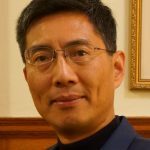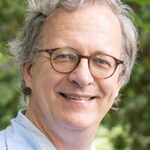Click here to return to the main program page.
Segment 1
Seminar 1: Eugene WANG 汪悅進 (Harvard CAMLab): “Buddhist Worldmaking: Chinese Cases”
- Why Buddhist Art is So Special and How to Read It?
- Buddhist Topography
- Body and Body Politics: Famensi 法門寺 | Ruiguangsi 瑞光寺
- What is Chinese Chan painting 禪畫? Or How to Visualize the Heart Sutra?
- Sight and Site: Worldmaking Around Pagoda
 Eugene Y. Wang is the Abby Aldrich Rockefeller Professor of Asian Art. A Guggenheim Fellow (2005), he is the art history editor of the Encyclopedia of Buddhism (2004). His extensive publications range from early Chinese to contemporary art. His book, Shaping the Lotus Sutra: Buddhist Visual Culture in Medieval China (2005), which received an academic award from Japan, explores Buddhist ways of worldmaking.
Eugene Y. Wang is the Abby Aldrich Rockefeller Professor of Asian Art. A Guggenheim Fellow (2005), he is the art history editor of the Encyclopedia of Buddhism (2004). His extensive publications range from early Chinese to contemporary art. His book, Shaping the Lotus Sutra: Buddhist Visual Culture in Medieval China (2005), which received an academic award from Japan, explores Buddhist ways of worldmaking.
He has served on advisory boards and review committees for the Center for Advanced Study in Visual Art, National Gallery of Art, Washington, DC, Getty Foundation, Mellon Foundation, etc.
His current research focuses on cognitive study of art. He is working on a book on Sonic Painting, probing the unheard soundscape and voice effect in pictures..
He is also the founding director of the Harvard FAS CAMLab (Chinese Art Media Lab). The lab explores multimedia storytelling and designs immersive artistic experience, turning humanistic research into creative sensorial media practice.
Please find reading materials for participants only here.
Seminar 2: Eric GREENE (Yale): “Buddhist Meditation in Early Medieval China: From An Shigao to Early Chan”
- The Chinese understanding of Buddhist Meditation (禪) in the Han and Three-Kingdoms Period
- The “chan scriptures” (禪經) and the First Chinese Traditions of Meditation Practice
- Visionary Meditation in the Fifth Century
- Early Tiantai 天台 Meditation
- The Transformation of Meditation in the Early Chan School (早期禪宗)
Please find reading materials for participants only here.
 Eric Greene is Assistant Professor of Religious Studies. He received his B.A. in Mathematics from Berkeley in 1998, followed by his M.A. (Asian Studies) and Ph.D. (Buddhist Studies) in 2012. He specializes in the history of medieval Chinese Buddhism, particularly the emergence of Chinese forms of Buddhism from the interaction between Indian Buddhism and indigenous Chinese culture. Much of his recent research has focused on Buddhist meditation practices, including the history of the transmission on Indian meditation practices to China, the development of distinctly Chinese forms of Buddhist meditation, and Buddhist rituals of confession and atonement. He is currently writing a book on the uses of meditative visionary experience as evidence of sanctity within early Chinese Buddhism. In addition to these topics, he has published articles on the early history of Chan (Zen) Buddhism, Buddhist paintings from the Silk Roads, and the influence of modern psychological terminology on the Western interpretation of Buddhism. He is also presently working on a new project concerning the practice of translation – from Indian languages to Chinese – in early Chinese Buddhism. He teaches undergraduate classes on Buddhism in East Asia, Zen Buddhism, ritual in East Asian Buddhism, and mysticism and meditation in Buddhism and East Asia, and graduate seminars on Chinese Buddhist studies and Chinese Buddhist texts.
Eric Greene is Assistant Professor of Religious Studies. He received his B.A. in Mathematics from Berkeley in 1998, followed by his M.A. (Asian Studies) and Ph.D. (Buddhist Studies) in 2012. He specializes in the history of medieval Chinese Buddhism, particularly the emergence of Chinese forms of Buddhism from the interaction between Indian Buddhism and indigenous Chinese culture. Much of his recent research has focused on Buddhist meditation practices, including the history of the transmission on Indian meditation practices to China, the development of distinctly Chinese forms of Buddhist meditation, and Buddhist rituals of confession and atonement. He is currently writing a book on the uses of meditative visionary experience as evidence of sanctity within early Chinese Buddhism. In addition to these topics, he has published articles on the early history of Chan (Zen) Buddhism, Buddhist paintings from the Silk Roads, and the influence of modern psychological terminology on the Western interpretation of Buddhism. He is also presently working on a new project concerning the practice of translation – from Indian languages to Chinese – in early Chinese Buddhism. He teaches undergraduate classes on Buddhism in East Asia, Zen Buddhism, ritual in East Asian Buddhism, and mysticism and meditation in Buddhism and East Asia, and graduate seminars on Chinese Buddhist studies and Chinese Buddhist texts.
Seminar 3: ZHAN Ru 湛如 (PekingU): “From Buddha-gayā to Nara: Pan-Asian Shifting of artistic, doctrinal and textual motifs in Buddhism”
 Zhan Ru is a Professor in Peking University’s School of Foreign Languages. Additionally, he is a member of the Chinese People’s Political Consultative Conference (CPPCC) National Committee, Vice President of the Buddhist Association of China and Vice President of the Peking University Orientalism Research Institute.
Zhan Ru is a Professor in Peking University’s School of Foreign Languages. Additionally, he is a member of the Chinese People’s Political Consultative Conference (CPPCC) National Committee, Vice President of the Buddhist Association of China and Vice President of the Peking University Orientalism Research Institute.
His areas of research include: Buddhist and Buddhist literature, the Indian Ministry of Buddhism, Dunhuang Buddhism, Buddhist system.
Lecture 1: August 5, 9:20am PDT – Paul COPP (Chicago): “Buddhism as ‘Material Religion’”
This lecture takes seals and their practices as a case in how to think about Buddhism as a “material religion.” By this term I mean a form of religious practice where physical objects and the behaviors in which they are used not only constitute important modes of that practice, but also help to shape even those of its aspects that might seem least “material,” such as doctrinal thought. I’ll explore how sealing practices, especially the ways they center ideas of identity and identity extension, shaped understandings of two crucial relationships in Buddhism: between student and teacher and between self or mind and world. We’ll focus on practice-generated metaphors such as “the Seal of the Buddha” and the haiyin sanmei 海印三昧, which we’ll see was understand in at least two different ways, as “the Samādhi of the Ocean of Reflections of Stamp-Like Clarity,” and the “Samādhi of the Oceanic Seal.”

Paul Copp is Associate Professor in Chinese Religion and Thought, East Asian Languages and Civilizations. His first book, The Body Incantatory: Spells and the Ritual Imagination in Medieval Chinese Buddhism, is a study of the nature and history of Buddhist incantatory and amuletic practices in Tang China, centered in archaeological evidence. He is currently writing two books. The first, a study of seals in Chinese religious practice from the Eastern Han through the Northern Song, is tentatively titled “The Ritualist’s Seal: Object, Practice, and Knowledge in Chinese Religion.” The working title of the second, a study of vernacular ritual practice centered in the Dunhuang materials, is “Manuscript, Print, and the Ritualist’s Craft.”
Lecture 2: August 7, 9:20am PDT – Lori MEEKS (USC): “Genres of Buddhist Preaching in Medieval and Early Modern Japan”
This lecture will provide an overview of some of the common genres of Buddhist teaching and preaching utilized in premodern Japan. How were Buddhist doctrinal ideas disseminated to a broader audience? What were some of the primary mechanisms through which ordinary laypeople—and especially women—came to learn about Buddhist texts and doctrines? I will focus, in particular, on examples of teaching and preaching that address women and discourses on women’s salvation.
 Lori Meeks is associate professor of religion and East Asian languages and cultures. Her current research is centered on the social and cultural history of Buddhism in Japanese history. Much of her work has focused on clarifying the roles of women as consumers and practitioners of Buddhism in the Heian and Kamakura periods (roughly ninth through early fourteenth centuries). She is editor, with James Benn and James Robson, of Buddhist Monasticism in East Asia: Places of Practice (Routledge, 2009). She is the author of Hokkeji and the Reemergence of Female Monastic Orders in Premodern Japan. Honolulu, HI: Kuroda Institute Studies in East Asian Buddhism (University of Hawaii Press, 2010).
Lori Meeks is associate professor of religion and East Asian languages and cultures. Her current research is centered on the social and cultural history of Buddhism in Japanese history. Much of her work has focused on clarifying the roles of women as consumers and practitioners of Buddhism in the Heian and Kamakura periods (roughly ninth through early fourteenth centuries). She is editor, with James Benn and James Robson, of Buddhist Monasticism in East Asia: Places of Practice (Routledge, 2009). She is the author of Hokkeji and the Reemergence of Female Monastic Orders in Premodern Japan. Honolulu, HI: Kuroda Institute Studies in East Asian Buddhism (University of Hawaii Press, 2010).
Segment 2
Seminar 4: Ulrike ROESLER (Oxford): “The Buddhist Scriptures in Tibet: Canon and Apocrypha”
- Introduction: The Tibetan Buddhist Canon
- How to Translate the Scriptures into Tibetan: A 9th century Treatise on Translation
- The Power of the Written Word: Book Culture in Tibet
- Buddhism as a Knowledge System: Studying, Reciting, and Transmitting the Scriptures
- Outside the Mainstream Canon: “Old Tantras”, “Treasure Texts”, and the Bön Canon
Please find reading materials for participants only here.
 Ulrike Roesler is Professor of Tibetan and Himalayan Studies at the University of Oxford. Before joining Oxford in this role, she obtained her PhD in Indian Studies in Germany, taught Indian and Tibetan Studies at the Universities of Marburg and Freiburg in Germany, and was the first Numata Lecturer in Buddhist Studies at Oxford (2005-07). Her research interests include the transmission of Buddhism from India to Tibet as well as Tibetan historiography, biographical writing, and narrative literature. Her book publications include Lives Lived, Lives Imagined: Biography in the Buddhist Traditions (ed. with L. Covill and S. Shaw, 2010), a study of the 11th century Buddhist master Po to ba Rin chen gsal (Frühe Quellen zum buddhistischen Stufenweg in Tibet, 2011), and Tibetan and Himalayan Healing (ed. with Ch. Ramble, 2015).
Ulrike Roesler is Professor of Tibetan and Himalayan Studies at the University of Oxford. Before joining Oxford in this role, she obtained her PhD in Indian Studies in Germany, taught Indian and Tibetan Studies at the Universities of Marburg and Freiburg in Germany, and was the first Numata Lecturer in Buddhist Studies at Oxford (2005-07). Her research interests include the transmission of Buddhism from India to Tibet as well as Tibetan historiography, biographical writing, and narrative literature. Her book publications include Lives Lived, Lives Imagined: Biography in the Buddhist Traditions (ed. with L. Covill and S. Shaw, 2010), a study of the 11th century Buddhist master Po to ba Rin chen gsal (Frühe Quellen zum buddhistischen Stufenweg in Tibet, 2011), and Tibetan and Himalayan Healing (ed. with Ch. Ramble, 2015).
Seminar 5: Imre GALAMBOS (Cambridge): “Buddhist texts across languages: The manuscripts of Central Asia”
- Introduction, general overview
- The translation of Buddhist texts
- Transliterating the sounds
- Reading Chinese texts in another language
- Reading Chinese texts in Chinese
Please find reading materials for participants only here.
 After having studied for several years in China (Tianjin) and Hungary, Imre Galambos received his Ph.D. from UC Berkeley with a dissertation on the orthography of Chinese writing during the Warring States period. Following his graduation he started working for the International Dunhuang Project at the British Library and became involved in the study of Dunhuang manuscripts and the manuscript culture of medieval China in general. After 10 years at the British Library, he moved to Cambridge in 2012.
After having studied for several years in China (Tianjin) and Hungary, Imre Galambos received his Ph.D. from UC Berkeley with a dissertation on the orthography of Chinese writing during the Warring States period. Following his graduation he started working for the International Dunhuang Project at the British Library and became involved in the study of Dunhuang manuscripts and the manuscript culture of medieval China in general. After 10 years at the British Library, he moved to Cambridge in 2012.
Seminar 6: Barend TER HAAR (Hamburg): “Lay approaches to Buddhism”
- What counts as “Buddhism” and what would lay Buddhism be?
- Early Buddhism and its lay religious context
- Early lay Buddhist movements (Song to Ming)
- Buddhist options within a larger menu
- Lay religious innovation int he later imperial period (late Ming to Republic)
Please find reading materials for participants only here.
 Barend ter Haar teaches Chinese studies at the University of Hamburg, with a strong focus on cultural and religious history. Although first of all a social and cultural historian, the religious dimension is so central to Chinese traditional life that much of his research up to now has dealt with religious phenomena. In addition, he has worked extensively on issues of ethnic identity, violence and fear, and social organization. An important concern of his is to demonstrate that traditional culture and cultural patterns are still relevant today, as becomes visible for instance in the case of the Falun Gong or the ongoing role of exorcist violence in political contexts throughout the twentieth century. For those who read Dutch, he has published a history of China, entitled The Heavenly Mandate: The history of the Chinese Empire until 1911 or Het Hemels Mandaat: De Geschiedenis van het Chinese Keizerrijk (AUP: Amsterdam, 2009) with a somewhat revisionist view on the Chinese past. His book on the lay Buddhist group called the Non-Action Teachings (late 16th century to the present) has come out with Hawai’i University Press, as Practicing Scripture: A Lay Buddhist Movement in Late Imperial China.
Barend ter Haar teaches Chinese studies at the University of Hamburg, with a strong focus on cultural and religious history. Although first of all a social and cultural historian, the religious dimension is so central to Chinese traditional life that much of his research up to now has dealt with religious phenomena. In addition, he has worked extensively on issues of ethnic identity, violence and fear, and social organization. An important concern of his is to demonstrate that traditional culture and cultural patterns are still relevant today, as becomes visible for instance in the case of the Falun Gong or the ongoing role of exorcist violence in political contexts throughout the twentieth century. For those who read Dutch, he has published a history of China, entitled The Heavenly Mandate: The history of the Chinese Empire until 1911 or Het Hemels Mandaat: De Geschiedenis van het Chinese Keizerrijk (AUP: Amsterdam, 2009) with a somewhat revisionist view on the Chinese past. His book on the lay Buddhist group called the Non-Action Teachings (late 16th century to the present) has come out with Hawai’i University Press, as Practicing Scripture: A Lay Buddhist Movement in Late Imperial China.
Lecture 3: August 20, 6:10am PDT –Jinhua JIA 賈晉華 (U Macau): “Perspectives in the Study of Classical Chan Buddhism”
Classical Chan Buddhism refers to the Chinese Chan tradition from Mazu Daoyi (709–788) and other Chan masters in the mid-Tang period to their descendants in the late-Tang and Five Dynasties. Discourses attributed to classical Chan masters and encounter stories about them have remained the core of Chan literature and have been repeatedly interpreted, elaborated, and eulogized. Their images have been idolized as representatives of Chan spirit and identity, not only by successors of the Chinese Chan tradition, but also by traditions of Korean Sŏn, Japanese Zen, and Vietnamese Thiên.
In recent decades, study on classical Chan has flourished. Many works have made new breakthrough in both textual and doctrinal studies. However, controversies have continued, and the central issue is still whether the classical Chan a historical existence in the Tang and Five Dynasties or a retrospective creation by Song-dynasty monks. Surrounding this central controversy, there have been two extreme opinions. On the one extreme, some scholars insist in accepting all the transmitted texts at face value and using them to describe the classical Chan history without any critical examination. On the other extreme, some scholars assert that all the texts were created by Song monks and the images of classical masters were simply the imagination of Song monks.
Both extreme opinions are problematic and not in accordance with historical facts. Our discussion will focus on challenging these extreme opinions from three perspectives: 1) the dating of the encounter dialogues attributed to classical Chan masters; 2) the making of the “iconoclastic” image of classical Chan Masters; 3) the beginning of the practice of gong’an (koan) Chan. Through careful textual comparison, we will find most of the famous encounter dialogues as well as the “iconoclastic” image of classical masters were mainly created by Five-Dynasties monks, who comprised a major part of the classical tradition, and Song monks’ contribution to classical Chan was collecting, extending, interpreting, and elaborating previous literature. Even the practice of gong’an Chan that has been generally regarded as a Song invention started in the Five Dynasties. The classical Chan tradition is an actual, historical existence, and the creative contribution of Five-Dynasties monks should be sufficiently recognized.

Jinhua Jia, PhD from University of Colorado at Boulder, is Adjunct Professor at University of Macau, Research Professor at Wuhan University, and Chair Professor at Yangzhou University. She had been Member of Institute for Advanced Study (Princeton), Fellow of National Humanities Center (USA), Research Associate of Harvard Divinity School, and Professor of Hong Kong Polytechnic University, City University of Hong Kong, and Xiamen University. Her research interests include Buddhist studies and traditional Chinese religion, philosophy, and literature. She is the author of many books and articles, including The Hongzhou School of Chan Buddhism in Eighth-through-Tenth Century China (SUNY 2006), Study on Classical Chan Buddhism (Oxford UP 2010, Kyūko Shoin 2018), Gender, Power, and Talent: Daoist Priestesses in Tang China (Columbia UP 2018), and From Ritual Culture to Classical Confucianism (Oriental Publication Center 2020).
